Celtic Cross Spread

Difficulty: Average
This is probably the most well-known tarot spread. A good, basic spread for beginners to practise with, the Celtic Cross is useful for questions of all types. In this spread, it can be helpful to notice the relationships between the pairings of cards #5 & #9, #1 & #2, #3 & #4, and #6 & #10.
- The significator epitomizes what the reading deals with, the initial situation.
- An added impulse that compounds the significator, which may be either complimentary or contradictory.
- This is what is consciously known (thoughts).
- Unconscious driving forces that may not be known fully (emotions).
- The immediate past regarding the current situation.
- The first future card indicates the immediate future.
- This card represents the reader and their attitude towards cards #1 and #2.
- The external influences, the places and people which influence the topic.
- This tarot card suggests expectations; what is secretly hoped for or feared.
- The second future card reveals the long-term outcome.
Your Celtic Cross Reading
The Crown |
The Outcome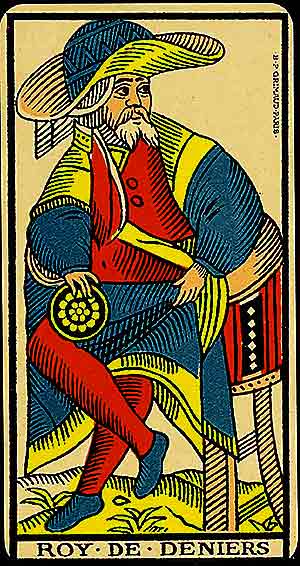 King of Coins
External Forces 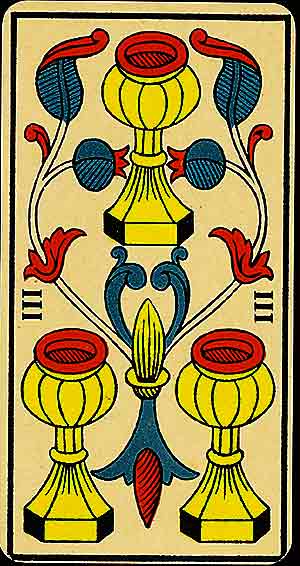 Three of Cups
|
||
The Recent Past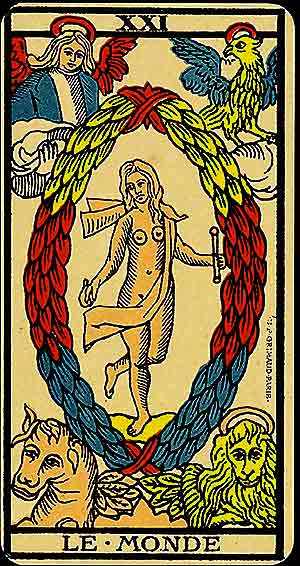 XXI – The World (Le Monde) |
The Crossing Card
|
The Future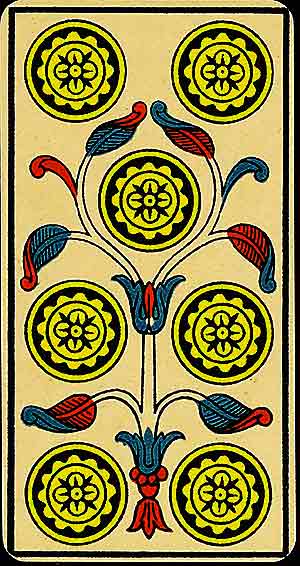 Seven of Coins |
|
|
|||
The Significator represents what the main theme of the reading deals with, the initial situation.
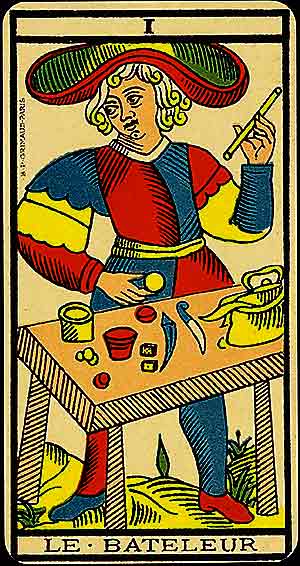
I – The Magician (Le Bateleur)
The Magician represents skill, potential, and the power to shape reality. As the first step in the Major Arcana, he symbolises the individual's awareness of their tools and the initiation of personal mastery.
Symbolism: The table before him holds simple tools—a cup, a coin, a blade, and a wand—representing the raw elements of life and their mastery. His wide-brimmed hat, resembling the lemniscate, speaks of infinite potential and dynamic creativity. The uneven terrain below mirrors his capacity to balance uncertainty with control.
In Relationships: A time to take initiative or charm your way into new connections. The Magician highlights personal magnetism but warns against manipulation.
In Work: A signal to harness your skills and capitalise on emerging opportunities. Confidence and action are key.
Spiritually: The Magician is the bridge between spirit and matter, teaching you to use divine gifts responsibly.
When ill-dignified: Deception, arrogance, or scattered energy. It warns against using talents for selfish or destructive ends.
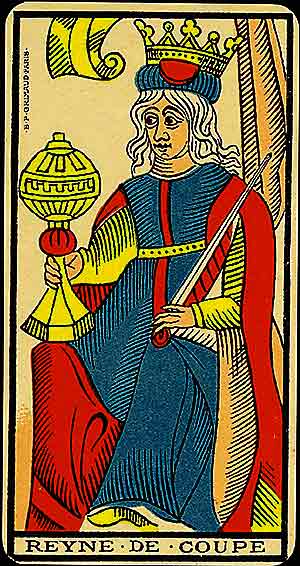
The Crossing Card denotes an added impulse that compounds the initial card, whether complimentary or contradictory.
Queen of Cups
The Queen of Cups embodies emotional depth, compassion, and intuitive wisdom. She represents the nurturing of emotions and the ability to comfort others.
Symbolism: Seated gracefully on her throne, the Queen holds a beautifully crafted cup, symbolising her mastery over emotions. Surrounding designs evoke her intuitive and healing energy.
In Relationships: This card signifies a loving, empathetic partner or deepening emotional bonds. It encourages open-hearted communication and mutual support.
In Work: The Queen highlights the importance of compassion and emotional intelligence. It suggests a role where empathy and intuition are vital for success.
Spiritually: The Queen reflects the mastery of your inner emotional world and the ability to channel intuition and empathy into healing and guidance.
When ill-dignified: Emotional overwhelm, dependence, or manipulation. It warns against losing yourself in emotions or using your sensitivity to control others.

The Crown stands for what the asker is aware of consciously.
V – The Pope (Le Pape)
The Hierophant bridges the earthly and the divine, symbolising tradition, spiritual guidance, and the transmission of sacred knowledge. He represents the connection between the seeker and a higher truth through structure and ritual.
Symbolism: The Hierophant sits between two pillars, a gesture of blessing extended towards two kneeling figures below him. His triple cross sceptre represents spiritual authority, while the two fingers pointing to his heart suggest access to divine mysteries. His serene expression reflects wisdom tempered with compassion.
In Relationships: A relationship built on shared values. It can also signify guidance or mentorship within a partnership.
In Work: Success through adherence to structure, tradition, or established methods. Seek advice from a mentor or institution.
Spiritually: The Hierophant invites the seeker to explore established spiritual paths, finding wisdom in teachings passed down through generations.
When ill-dignified: Dogmatism, resistance to change, or blind adherence to tradition. It warns against sacrificing individuality for conformity.

Foundation card reveals unconscious driving forces that the querent may not be aware of.
Three of Batons
The Three of Batons signifies expansion and the realisation of early progress. It is a card of growth through exploration and the courage to venture into new realms.
Symbolism: Three batons interlace harmoniously, with flourishing leaves that reflect growth. The triangular crossing suggests stability in motion, as progress unfolds from a solid foundation.
In Relationships: Relationships flourish through shared aspirations and mutual support. It may indicate exploring new horizons together.
In Work: Initial successes lead to broader opportunities. This card encourages continued effort and long-term vision.
Spiritually: A reminder to expand your perspective and trust the journey towards greater understanding.
When ill-dignified: Frustration or delays in progress. It warns against complacency or overconfidence.

The Recent Past represents past events and concerns.
XXI – The World (Le Monde)
The World is the culmination of the journey, representing fulfilment, harmony, and unity. It signifies the integration of all aspects of life and the successful completion of a cycle, opening the way to new beginnings.
Symbolism: A central figure dances within a laurel wreath, symbolising victory and wholeness. The four corners often depict symbolic creatures (the lion, ox, eagle, and man), representing the elements, the fixed signs of the zodiac, or the four faces of a cherubim. The wreath signifies completion and eternity.
In Relationships: A harmonious, complete relationship or fulfilment of long-term goals in love. It reflects unity and shared purpose.
In Work: The successful culmination of a project or phase. Recognition and achievement mark this time of completion.
Spiritually: Le Monde invites the seeker to embrace the interconnectedness of all things, celebrating unity with the divine and readiness for new journeys.
When ill-dignified: Incompletion, stagnation, or feeling unfulfilled despite external success. It warns against losing sight of the bigger picture or resisting closure.

The Future depicts that which lies ahead.
Queen of Cups
The Queen of Cups embodies emotional depth, compassion, and intuitive wisdom. She represents the nurturing of emotions and the ability to comfort others.
Symbolism: Seated gracefully on her throne, the Queen holds a beautifully crafted cup, symbolising her mastery over emotions. Surrounding designs evoke her intuitive and healing energy.
In Relationships: This card signifies a loving, empathetic partner or deepening emotional bonds. It encourages open-hearted communication and mutual support.
In Work: The Queen highlights the importance of compassion and emotional intelligence. It suggests a role where empathy and intuition are vital for success.
Spiritually: The Queen reflects the mastery of your inner emotional world and the ability to channel intuition and empathy into healing and guidance.
When ill-dignified: Emotional overwhelm, dependence, or manipulation. It warns against losing yourself in emotions or using your sensitivity to control others.
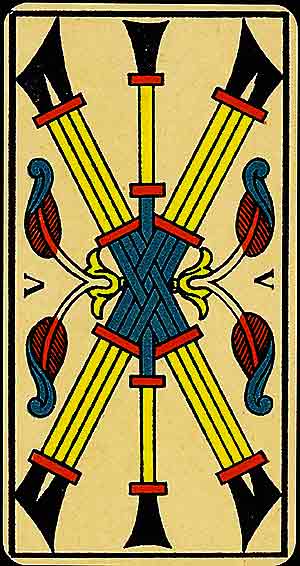
The Querent represents the asker and their attitude towards the subject of the reading.
Five of Batons
The Five of Batons symbolises conflict, competition, and the energy of creative tension. It challenges the seeker to navigate dynamic forces to achieve growth.
Symbolism: Five batons intersect in a crossing pattern, forming two triangles. Despite the opposition, leaves sprout at the junctions, suggesting that conflict can lead to creative breakthroughs.
In Relationships: Disagreements or challenges that require honest communication and compromise.
In Work: Competition or conflicting ideas in the workplace. Success comes through persistence and collaboration.
Spiritually: The card reflects internal struggles and the need to reconcile opposing desires to find clarity.
When ill-dignified: Escalating conflict, lack of cooperation, or destructive rivalry. It warns against letting tensions derail progress.

External Forces represents the influence of others in your life as well as trends in your relationships with others.
Three of Cups
The Three of Cups signifies celebration, joy, and the strength of community. It highlights the beauty of shared experiences and collective support.
Symbolism: Three cups are arranged in a triangular formation, adorned with floral embellishments. The triangular structure represents unity and the joy of collaboration, while the flourishing details reflect abundance and festivity.
In Relationships: A period of happiness and shared experiences. It may also signify joyful gatherings.
In Work: Success celebrated with colleagues or recognition of collaborative achievements.
Spiritually: The card encourages gratitude and participation in rituals or practices that foster collective growth and harmony.
When ill-dignified: Overindulgence, superficial connections, or neglecting personal boundaries. It warns against prioritising social validation over genuine connection.

Hopes and Fears shows the expectations you have concerning the outcome of your question.
Four of Swords
The Four of Swords symbolises rest, recuperation, and mental clarity achieved through stillness. It reflects the need for pause before taking further action.
Symbolism: Four curved swords form an oval frame, with interwoven bindings at the top and bottom, creating a sense of structure and containment. At the centre of the composition, a single blooming flower emerges, symbolising peace, recovery, and renewal. The flowing curves and woven intersections suggest a more organic approach to rest and contemplation. The imagery highlights the importance of finding harmony within stillness, reinforcing the idea that mental clarity arises when balance and inner peace are embraced.
In Relationships: A period of emotional detachment or taking space to reflect on a relationship's direction.
In Work: A time for rest or strategic planning. Progress will come after regrouping and gathering strength.
Spiritually: The card invites retreat into meditation or introspection to realign with higher truths.
When ill-dignified: Stagnation, resistance to rest, or avoidance of necessary reflection. It warns against burnout or neglecting self-care.

The Outcome of your question. Interpret this card in the context of the entire reading and as an indicator of the path you are currently on, but not necessarily bound to.
King of Coins
The King of Coins represents mastery, security, and leadership in the material realm. He embodies the culmination of efforts to achieve prosperity and the wisdom to manage it responsibly.
Symbolism: The King sits on his throne, holding a coin against his thigh. His rich attire and the solid, grounded posture of his figure reflect his wealth, stability, and ability to create and sustain abundance. His gaze suggests foresight and the ability to guide others.
In Relationships: A stable, protective partner who values commitment and security. The card encourages cultivating trust and shared goals.
In Work: Leadership, financial success, and the ability to manage resources wisely. This card highlights mastery in your field and the respect of peers.
Spiritually: The King teaches the value of integrating spiritual wisdom with material responsibility, urging you to be a steward of their blessings.
When ill-dignified: Greed, arrogance, or misuse of power. It warns against becoming overly controlling or neglecting emotional connections in pursuit of material gain.